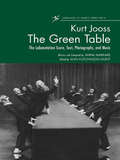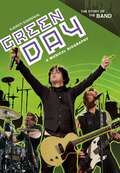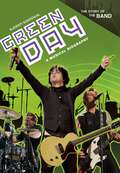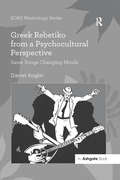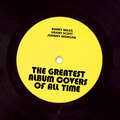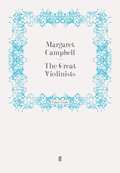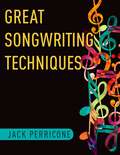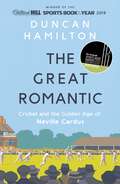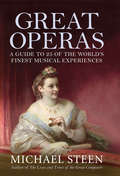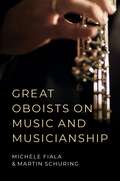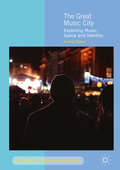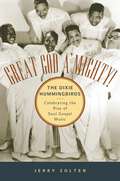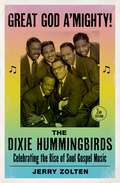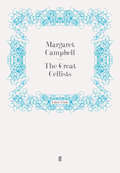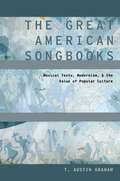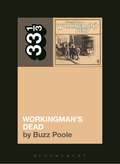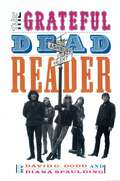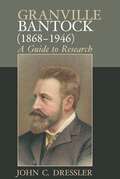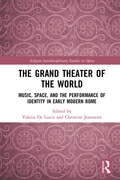- Table View
- List View
The Green Table: The Labanotation Score, Text, Photographs, and Music
by Ann Hutchinson Guest* Score, photographs, and production details of one of this century's best-loved ballets * Includes rare archival material * Packaged with audio CD This work brings together the complete dance score of The Green Table--one of the most famous ballets of the 20th century--in Labanotation, along with music notation for the piano accompaniment and a complete recording of the accompaniment on CD. It also includes several essays about the work and its genesis, and many historic production photographs. This book is an important item for all colleges with dance programs to own in their libraries and for scholars interested in the study of contemporary dance.
Green Day: A Musical Biography (The Story of the Band)
by Kjersti EgerdahlHere is an up-to-date, thoroughly researched biography of the world's most popular pop-punk band.Green Day is almost certainly the world's most popular pop-punk band. How they got there is the subject of Green Day: A Musical Biography, the first book to follow the band from their beginnings through the spring 2009 release of 21st Century Breakdown. Tracing the band's evolution from fiercely independent punks to a global powerhouse, Green Day starts with the members' earliest musical influences and upbringing and the founding of the punk club 924 Gilman Street that shaped their sense of community. Discussion of their conflicted feelings about signing to a major label explores the classic rock 'n' roll conundrum of "selling out," while details of their decline and 2004 rebirth offer an inspirational story of artistic rejuvenation. Interviews with the band members and key figures in their lives, excerpted from punk 'zines and other publications, offer a perspective on their methods of self-promotion and the image they have chosen to project over time.
Green Day: A Musical Biography (The Story of the Band)
by Kjersti EgerdahlHere is an up-to-date, thoroughly researched biography of the world's most popular pop-punk band.Green Day is almost certainly the world's most popular pop-punk band. How they got there is the subject of Green Day: A Musical Biography, the first book to follow the band from their beginnings through the spring 2009 release of 21st Century Breakdown. Tracing the band's evolution from fiercely independent punks to a global powerhouse, Green Day starts with the members' earliest musical influences and upbringing and the founding of the punk club 924 Gilman Street that shaped their sense of community. Discussion of their conflicted feelings about signing to a major label explores the classic rock 'n' roll conundrum of "selling out," while details of their decline and 2004 rebirth offer an inspirational story of artistic rejuvenation. Interviews with the band members and key figures in their lives, excerpted from punk 'zines and other publications, offer a perspective on their methods of self-promotion and the image they have chosen to project over time.
Greek Rebetiko from a Psychocultural Perspective: Same Songs Changing Minds (SOAS Studies in Music Series)
by Daniel KoglinGreek Rebetiko from a Psychocultural Perspective: Same Songs Changing Minds examines the ways in which audiences in present-day Greece and Turkey perceive and use the Greek popular song genre rebetiko to cultivate specific cultural habits and identities. In the past, rebetiko has been associated chiefly with the lower strata of Greek society. But Daniel Koglin approaches the subject from a different perspective, exploring the mythological and ritual aspects of rebetiko, which intellectual elites on both sides of the Aegean Sea have adapted to their own world views in our age of globalized consumption. Combining qualitative and quantitative methods from ethnomusicology, ritual studies, conceptual history and music psychology, Koglin casts light on the role played by national perceptions in the processes of music production and consumption. His analysis reveals that rebetiko persistently oscillates between conceptual categories: it is a music both ours and theirs, marginal and mainstream, joyful and grievous, sacred and profane. The study culminates in the thesis that this semantic multistability is not only a key concept to understanding the ongoing popularity of rebetiko in Greece, and its recent renaissance in Turkey, but also a fundamental aspect of the human experience on the south-eastern borders of Europe.
Greek Rebetiko from a Psychocultural Perspective: Same Songs Changing Minds (SOAS Studies in Music Series)
by Daniel KoglinGreek Rebetiko from a Psychocultural Perspective: Same Songs Changing Minds examines the ways in which audiences in present-day Greece and Turkey perceive and use the Greek popular song genre rebetiko to cultivate specific cultural habits and identities. In the past, rebetiko has been associated chiefly with the lower strata of Greek society. But Daniel Koglin approaches the subject from a different perspective, exploring the mythological and ritual aspects of rebetiko, which intellectual elites on both sides of the Aegean Sea have adapted to their own world views in our age of globalized consumption. Combining qualitative and quantitative methods from ethnomusicology, ritual studies, conceptual history and music psychology, Koglin casts light on the role played by national perceptions in the processes of music production and consumption. His analysis reveals that rebetiko persistently oscillates between conceptual categories: it is a music both ours and theirs, marginal and mainstream, joyful and grievous, sacred and profane. The study culminates in the thesis that this semantic multistability is not only a key concept to understanding the ongoing popularity of rebetiko in Greece, and its recent renaissance in Turkey, but also a fundamental aspect of the human experience on the south-eastern borders of Europe.
The Greatest Album Covers of All Time
by Barry Miles Grant Scott Johnny MorganWith the resurgence of vinyl going from strength to strength, album cover art is as important as it's ever been. This sumptuous book brings together 250 of the greatest album covers of all time and is arranged chronologically, beginning in 1956. Our judging panel, drawn from the great and the good of the music industry, has selected the final 275 entries, giving their reasons for selection to accompany the illustrations. From rock ‘n’ roll to pop, R&B to jazz, blues and even folk, some of the album covers included are obvious classics, while others will surprise readers and jog memories. The chosen entries might not necessarily be of a best-selling release, but they are important artistically, stylistically or culturally. This fascinating book forms a wonderful visual record of this popular art form, and is an essential read for music fans the world over.
The Great Violinists (Great Musicians #2)
by Margaret CampbellThis carefully researched and definitive book recreates the magic of the greatest violinists in history. In three centuries, the solo performer progressed from downtrodden private servant to revered public idol. The supreme artists Corelli, Vivaldi, Viotti, Paganini, Vieuxtemps, Joachim and Auer were pivotal figures in the history of violin playing, while more recent times have seen Sarasate, Ysaye and the virtuosi of the modern recording era. The Great Violinists reveals a range of personalities from the conventional to the eccentric. In her coverage of the last hundred years, Margaret Campbell has interviewed many eminent musicians and had rich access to letters and private documents. Her book offers a vivid portrait of skills and traditions that have been handed down through generations. It is a book for string players, students, concert goers and music buffs - indeed, anyone who enjoys the sound of the violin.
GREAT SONGWRITING TECHNIQUES C
by Jack PerriconeIn Great Songwriting Techniques, veteran composer and teacher Jack Perricone shares years of experience in the art, science, and pedagogy of songwriting to teach readers the craft. Whether they write for a small group of friends or in the hopes of creating a smash hit, aspiring songwriters can learn how to focus on topics essential to their success in this competitive field; every songwriter must be aware of audience, thick-skinned enough to handle rejection and competition, and most importantly have the confidence to master the craft of composing and producing. Perricone teaches readers to accomplish this through a targeted series of lessons on key elements of songwriting from building blocks like melody, harmony, and rhythm to more advanced topics like lyric placement and tone texture. Chapters explore loop-based harmonic patterns, tone tendencies, form, function, and lyric writing, all in service of preparing the aspiring songwriter to be a master of prosody and keen in understanding the relationship between words and music. The volume includes examples of exceptional songwriting from well-known artists such as Irving Berlin, Prince, Bob Dylan, Stevie Wonder, Justin Timberlake, and Taylor Swift.
Great Songwriting Techniques
by Jack PerriconeIn Great Songwriting Techniques, veteran composer and teacher Jack Perricone shares years of experience in the art, science, and pedagogy of songwriting to teach readers the craft. Whether they write for a small group of friends or in the hopes of creating a smash hit, aspiring songwriters can learn how to focus on topics essential to their success in this competitive field; every songwriter must be aware of audience, thick-skinned enough to handle rejection and competition, and most importantly have the confidence to master the craft of composing and producing. Perricone teaches readers to accomplish this through a targeted series of lessons on key elements of songwriting from building blocks like melody, harmony, and rhythm to more advanced topics like lyric placement and tone texture. Chapters explore loop-based harmonic patterns, tone tendencies, form, function, and lyric writing, all in service of preparing the aspiring songwriter to be a master of prosody and keen in understanding the relationship between words and music. The volume includes examples of exceptional songwriting from well-known artists such as Irving Berlin, Prince, Bob Dylan, Stevie Wonder, Justin Timberlake, and Taylor Swift.
The Great Romantic: Cricket and the golden age of Neville Cardus - Winner of the William Hill Sports Book of the Year
by Duncan HamiltonNeville Cardus described how one majestic stroke-maker 'made music' and 'spread beauty' with his bat. Between two world wars, he became the laureate of cricket by doing the same with words.In The Great Romantic, award-winning author Duncan Hamilton demonstrates how Cardus changed sports journalism for ever. While popularising cricket - while appealing, in Cardus' words to people who 'didn't know a leg-break from the pavilion cat at Lord's'- he became a star in his own right with exquisite phrase-making, disdain for statistics and a penchant for literary and musical allusions. Among those who venerated Cardus were PG Wodehouse, John Arlott, Harold Pinter, JB Priestley and Don Bradman. However, behind the rhapsody in blue skies, green grass and colourful characters, this richly evocative biography finds that Cardus' mother was a prostitute, he never knew his father and he received negligible education. Infatuations with younger women ran parallel to a decidedly unromantic marriage. And, astonishingly, the supreme stylist's aversion to factual accuracy led to his reporting on matches he never attended. Yet Cardus also belied his impoverished origins to prosper in a second class-conscious profession, becoming a music critic of international renown. The Great Romantic uncovers the dark enigma within a golden age.
Great Operas: A Guide to Twenty-Five of the World's Finest Musical Experiences (Great Operas)
by Michael SteenWith four famous operas each from Mozart, Verdi and Puccini, and two each from Rossini and Donizetti, there is a feast of information. Here are short guides to The Marriage of Figaro and Don Giovanni; to the splendour of Aïda, the heart-breaking La Traviata; the drama of Tosca. The range is very broad. There is Wagner’s great love story Tristan und Isolde; there is Johann Strauss’s light comedy Die Fledermaus. On the way you can be briefed about such favourites as Handel’s Giulio Cesare, Bizet’s Carmen, Gounod’s Faust, Tchaikovsky’s Eugene Onegin and Britten’s Peter Grimes. With plot summaries, composer biographies, observations on musical points of interest and background on the historical and cultural context of each opera, every one of these guides will enhance your appreciation and enjoyment and help you discuss the work and the performance with your fellow opera-goers. Steen shares his expert knowledge with a lightness of touch that makes each guide a pleasure to read. Witty, informative and beautifully presented, Great Operas is an indispensable reference guide for both seasoned opera-goers and those enjoying opera for the first time.
Great Oboists on Music and Musicianship
by Michele L. Fiala Martin SchuringWhat do the world's most prominent oboists have to say about their musical ideas, performance techniques, and teaching strategies? Michele L. Fiala and Martin Schuring, themselves skilled oboists, undertook the project of asking twenty-six of them about their musicianship and pedagogy. The results are collected in Great Oboists on Music and Musicianship, which provides a unique window into how these virtuosi of wind instruments think about their craft. Each chapter paints an engaging portrait of a leading oboist that allows them to share--in their own words--their insights on the performance techniques, learning strategies, and career moves that propelled them to their current stature. The captivating prose chapters that Fiala and Schuring composed from the interviews allow each artist's personality to shine through as they convey their hard-won wisdom on topics such as musical interpretation, the relationship between vocal and instrumental music, being a good ensemble player, and warm-up routines. The diverse array of musicians portrayed in this book includes orchestral and solo performers from across North America, Europe, and Australia. Their practical advice will resonate not just with oboists but also with players and teachers of other instruments as they pursue their own musical journeys.
Great Oboists on Music and Musicianship
by Michele L. Fiala Martin SchuringWhat do the world's most prominent oboists have to say about their musical ideas, performance techniques, and teaching strategies? Michele L. Fiala and Martin Schuring, themselves skilled oboists, undertook the project of asking twenty-six of them about their musicianship and pedagogy. The results are collected in Great Oboists on Music and Musicianship, which provides a unique window into how these virtuosi of wind instruments think about their craft. Each chapter paints an engaging portrait of a leading oboist that allows them to share--in their own words--their insights on the performance techniques, learning strategies, and career moves that propelled them to their current stature. The captivating prose chapters that Fiala and Schuring composed from the interviews allow each artist's personality to shine through as they convey their hard-won wisdom on topics such as musical interpretation, the relationship between vocal and instrumental music, being a good ensemble player, and warm-up routines. The diverse array of musicians portrayed in this book includes orchestral and solo performers from across North America, Europe, and Australia. Their practical advice will resonate not just with oboists but also with players and teachers of other instruments as they pursue their own musical journeys.
The Great Music City: Exploring Music, Space and Identity (Pop Music, Culture and Identity)
by Andrea BakerIn the 1960s, as gentrification took hold of New York City, Jane Jacobs predicted that the city would become the true player in the global system. Indeed, in the 21st century more meaningful comparisons can be made between cities than between nations and states. Based on case studies of Melbourne, Austin and Berlin, this book is the first in-depth study to combine academic and industry analysis of the music cities phenomenon. Using four distinctly defined algorithms as benchmarks, it interrogates Richard Florida’s creative cities thesis and applies a much-needed synergy of urban sociology and musicology to the concept, mediated by a journalism lens. Building on seminal work by Robert Park, Lewis Mumford and Jane Jacobs, it argues that journalists are the cultural branders and street theorists whose ethnographic approach offers critical insights into the urban sociability of music activity.
Great God A'Mighty! The Dixie Hummingbirds: Celebrating the Rise of Soul Gospel Music
by Jerry ZoltenFrom the Jim Crow world of 1920s Greenville, South Carolina, to Greenwich Village's Café Society in the '40s, to their 1974 Grammy-winning collaboration on "Loves Me Like a Rock," the Dixie Hummingbirds have been one of gospel's most durable and inspiring groups. Now, Jerry Zolten tells the Hummingbirds' fascinating story and with it the story of a changing music industry and a changing nation. When James Davis and his high-school friends starting singing together in a rural South Carolina church they could not have foreseen the road that was about to unfold before them. They began a ten-year jaunt of "wildcatting," traveling from town to town, working local radio stations, schools, and churches, struggling to make a name for themselves. By 1939 the a cappella singers were recording their four-part harmony spirituals on the prestigious Decca label. By 1942 they had moved north to Philadelphia and then New York where, backed by Lester Young's band, they regularly brought the house down at the city's first integrated nightclub, Café Society. From there the group rode a wave of popularity that would propel them to nation-wide tours, major record contracts, collaborations with Stevie Wonder and Paul Simon, and a career still vibrant today as they approach their seventy-fifth anniversary. Drawing generously on interviews with Hank Ballard, Otis Williams, and other artists who worked with the Hummingbirds, as well as with members James Davis, Ira Tucker, Howard Carroll, and many others, The Dixie Hummingbirds brings vividly to life the growth of a gospel group and of gospel music itself.
Great God A'Mighty! The Dixie Hummingbirds: Celebrating the Rise of Soul Gospel Music
by Jerry ZoltenThe venerable Dixie Hummingbirds stand at the top of the black gospel music pantheon as artists who not only significantly shaped that genre but, in the process, also profoundly influenced emerging American pop music genres from Rhythm & Blues and Doo-Wop to Rock 'n' Roll, Soul, and Hip-Hop. Great God A'Mighty! The Dixie Hummingbirds shows how, in a career spanning more than nine decades, they pointed the way from pure a cappella harmony to guitar-driven soul to pop-stardom crossover, collaborating with artists like Stevie Wonder and Paul Simon along the way. Drawing on interviews with founding and quintessential members as well as many of the pop luminaries influenced by the Hummingbirds, author Jerry Zolten tells their story from rising up and out of the segregated South in the twenties and thirties to success on Philadelphia radio and the New York City stage in the forties to grueling tours in the fifties and over the long haul a brilliant recording career that carried well over into the 21st century. The story of the Dixie Hummingbirds is a tale of determined young men who navigated the troubled waters of racial division and the cutthroat business of music on the strength of raw talent, vision, character, and perseverance, and made an indelible name for themselves in American cultural history. This heavily edited 2nd edition features brand new photographs, expanded historical context, and a full new chapter on the Hummigbirds' trajectory up to the 21st century.
Great God A'Mighty! The Dixie Hummingbirds: Celebrating the Rise of Soul Gospel Music
by Jerry ZoltenThe venerable Dixie Hummingbirds stand at the top of the black gospel music pantheon as artists who not only significantly shaped that genre but, in the process, also profoundly influenced emerging American pop music genres from Rhythm & Blues and Doo-Wop to Rock 'n' Roll, Soul, and Hip-Hop. Great God A'Mighty! The Dixie Hummingbirds shows how, in a career spanning more than nine decades, they pointed the way from pure a cappella harmony to guitar-driven soul to pop-stardom crossover, collaborating with artists like Stevie Wonder and Paul Simon along the way. Drawing on interviews with founding and quintessential members as well as many of the pop luminaries influenced by the Hummingbirds, author Jerry Zolten tells their story from rising up and out of the segregated South in the twenties and thirties to success on Philadelphia radio and the New York City stage in the forties to grueling tours in the fifties and over the long haul a brilliant recording career that carried well over into the 21st century. The story of the Dixie Hummingbirds is a tale of determined young men who navigated the troubled waters of racial division and the cutthroat business of music on the strength of raw talent, vision, character, and perseverance, and made an indelible name for themselves in American cultural history. This heavily edited 2nd edition features brand new photographs, expanded historical context, and a full new chapter on the Hummigbirds' trajectory up to the 21st century.
The Great Cellists (Great Musicians #1)
by Margaret CampbellThe Great Cellists is a comprehensive and authoritative history of the lives and work of the cello's great performers and teachers, from the emergence of the solo instrument in the seventeenth century to the present day.In its early history, the cello was a genuine 'bass' violin that came in three sizes and from the thirteenth century was played side by side with viols and later violins. The instrument we know today came into general use by the time the great makers of the seventeenth and eighteenth centuries - such as Amati, Stradivari and Guarneri - brought their craft to perfection and made numerous of the instruments most sought after by today's virtuosi.Many of the earliest known professional cellists were employed as court musicians, but their names have not been widely known. The most familiar names belong to those early cellists who were also composers: Boccherini, Romberg, Piatti and Popper. In more recent times, the great Europeans Becker, Klengel and Salmond led to Feuermann, Piatogorsky, Fournier, Rostropovich, and above all to Casals; and they, in turn, have greatly influenced contemporary musicians such as the late Jacqueline du Pr� and the manifold brilliant players from Russia, Japan and the USA. The Great Cellists reveals a splendid range of personalities from the conventional to the eccentric. Included also are the numerous less well-known cellists who were important as founders of the various national 'schools'.Margaret Campbell has interviewed many eminent musicians and had rich access to letters and private documents in her coverage of the last hundred years. Her absorbing book presents to the reader a rich vision of skills and traditions that have been handed down nationally through the generations, and developed internationally since the twentieth century. It is a book for string players, students, concertgoers and CD buffs - indeed, anyone who enjoys the sound of the cello.
The Great American Songbooks: Musical Texts, Modernism, and the Value of Popular Culture (Modernist Literature and Culture)
by T. Austin GrahamIn the late nineteenth and early twentieth centuries, American authors pioneered a mode of musical writing that quite literally resounded beyond the printed page. Novels gained soundtracks, poetry compelled its audiences to sing, and the ostensibly silent act of reading became anything but. The Great American Songbooks is the story of this literature, at once an overview of musical and authorial practice at the century's turn, an investigation into the sensory dimensions of reading, and a meditation on the effects that the popular arts have had on literary modernism. The writings of John Dos Passos, Theodore Dreiser, T.S. Eliot, F. Scott Fitzgerald, Langston Hughes, Jean Toomer, and Walt Whitman are heard in a new key; the performers and tunesmiths who inspired them have their stories told; and the music of the past, long out of print and fashion, is recapitulated and made available in digital form. A work of criticism situated at the crossroads of literary analysis, musicology, and cultural history, The Great American Songbooks demonstrates the importance of studying fiction and poetry from interdisciplinary perspectives, and it suggests new avenues for research in the dawning age of the digital humanities.
Grateful Dead's Workingman's Dead (33 1/3)
by Buzz PooleReleased in 1970, Workingman's Dead was the breakthrough album for the Grateful Dead, a cold-water-shock departure from the Acid Test madness of the late '60s. It was the band's most commercially and critically successful release to date. More importantly, these songs established the blueprint for how the Dead would maintain and build upon a community held together by the core motivation of rejecting the status quo – the "straight life†? – in order to live and work on their own terms. As a unified whole, the album's eight songs serve as points of entry into a fully-rendered portrait of the Grateful Dead within the context of late twentieth-century American history. These songs speak to the attendant cultural and political anxieties that resulted from the idealism of the '60s giving way to the uncomfortable realities of the '70s, and the band's evolving perspective on these changes. Based on research, interviews, and personal experience, this book probes the paradox at the heart of the band's appeal: the Grateful Dead were about much more than music, though they were really just about the music.
Grateful Dead's Workingman's Dead (33 1/3)
by Buzz PooleReleased in 1970, Workingman's Dead was the breakthrough album for the Grateful Dead, a cold-water-shock departure from the Acid Test madness of the late '60s. It was the band's most commercially and critically successful release to date. More importantly, these songs established the blueprint for how the Dead would maintain and build upon a community held together by the core motivation of rejecting the status quo – the “straight life” – in order to live and work on their own terms. As a unified whole, the album's eight songs serve as points of entry into a fully-rendered portrait of the Grateful Dead within the context of late twentieth-century American history. These songs speak to the attendant cultural and political anxieties that resulted from the idealism of the '60s giving way to the uncomfortable realities of the '70s, and the band's evolving perspective on these changes. Based on research, interviews, and personal experience, this book probes the paradox at the heart of the band's appeal: the Grateful Dead were about much more than music, though they were really just about the music.
The Grateful Dead Reader (Readers on American Musicians)
Arranged in chronological order, these pieces add up to nothing less than a full-scale history of the greatest tour band in the history of rock. From Tom Wolfe's account of the Dead's first performance as the Grateful Dead (at an Acid Test in 1965), to Ralph Gleason's 1967 interview with the 24-year-old Jerry Garcia, to Mary Eisenhart's obituary of the beloved leader of the band, these selections include not only outstanding writing on the band itself, but also superb pieces on music and pop culture generally. Fans will be fascinated by the poetry, fiction, drawings, and rare and revealing photographs featured in the book, as well as the anthology's many interviews and profiles, interpretations of lyrics, and concert and record reviews. Still, The Grateful Dead was more than a band--it was a cultural phenomenon. For three decades it remained on one unending tour, followed everywhere by a small army of nomadic fans. This phenomenon is both analyzed and celebrated here, in such pieces as Ed McClanahan's groundbreaking article in Playboy in 1972, fan-magazine editor Blair Jackson's 1990 essay on the seriousness of the drug situation at Dead concerts, and Steve Silberman's insightful essays on the music and its fans.
Granville Bantock: A Guide to Research (Clemson University Press)
by John C. DresslerThe book will contain location and descriptive details of Bantock's manuscripts that are extant, which will assist those looking to construct editions of those works which have remained in manuscript and updated editions of those works which were initially published nearly 100 years ago. A discography provides insight into the wide variety of recording companies that first served Bantock’s music. It also includes more recent and more highly refined recording sonics that help listeners hear these works in a much more solid balance and quality of sound than the multitude of 78 rpm recordings which form the initial recordings of any of Bantock’s pieces. Included in the book are sections which highlight academic theses and dissertations that discuss some of Bantock’s works. In addition citations of locations of many of Bantock’s letters still available for study are included. An index that cross-references all of these details to the works which they highlight is a major help to the reader.
The Grand Theater of the World: Music, Space, and the Performance of Identity in Early Modern Rome (Ashgate Interdisciplinary Studies in Opera)
by Valeria De Lucca Christine JeanneretMusic and space in the early modern world shaped each other in profound ways, and this is particularly apparent when considering Rome, a city that defined itself as the "grande teatro del mondo". The aim of this book is to consider music and space as fundamental elements in the performance of identity in early modern Rome. Rome’s unique milieu, as defined by spiritual and political power, as well as diplomacy and competition between aristocratic families, offers an exceptionally wide array of musical spaces and practices to be explored from an interdisciplinary perspective. Space is viewed as the theatrical backdrop against which to study a variety of musical practices in their functions as signifiers of social and political meanings. The editors wish to go beyond the traditional distinction between music theatrical spectacles – namely opera – and other musical genres and practices to offer a more comprehensive perspective on the ways in which not only dramatic, but also instrumental music and even the sounds of voices and objects in the streets relied on the theatrical dimension of space for their effectiveness in conveying social and political messages. While most chapters deal with musical performances, some focus on specific aspects of the Roman soundscape, or are even intentionally "silent", dealing with visual arts and architecture in their performative and theatrical aspects. The latter offer a perspective that creates a visual counterpoint to the ways in which music and sound shaped space.
The Grand Theater of the World: Music, Space, and the Performance of Identity in Early Modern Rome (Ashgate Interdisciplinary Studies in Opera)
by Valeria De Lucca Christine JeanneretMusic and space in the early modern world shaped each other in profound ways, and this is particularly apparent when considering Rome, a city that defined itself as the "grande teatro del mondo". The aim of this book is to consider music and space as fundamental elements in the performance of identity in early modern Rome. Rome’s unique milieu, as defined by spiritual and political power, as well as diplomacy and competition between aristocratic families, offers an exceptionally wide array of musical spaces and practices to be explored from an interdisciplinary perspective. Space is viewed as the theatrical backdrop against which to study a variety of musical practices in their functions as signifiers of social and political meanings. The editors wish to go beyond the traditional distinction between music theatrical spectacles – namely opera – and other musical genres and practices to offer a more comprehensive perspective on the ways in which not only dramatic, but also instrumental music and even the sounds of voices and objects in the streets relied on the theatrical dimension of space for their effectiveness in conveying social and political messages. While most chapters deal with musical performances, some focus on specific aspects of the Roman soundscape, or are even intentionally "silent", dealing with visual arts and architecture in their performative and theatrical aspects. The latter offer a perspective that creates a visual counterpoint to the ways in which music and sound shaped space.
